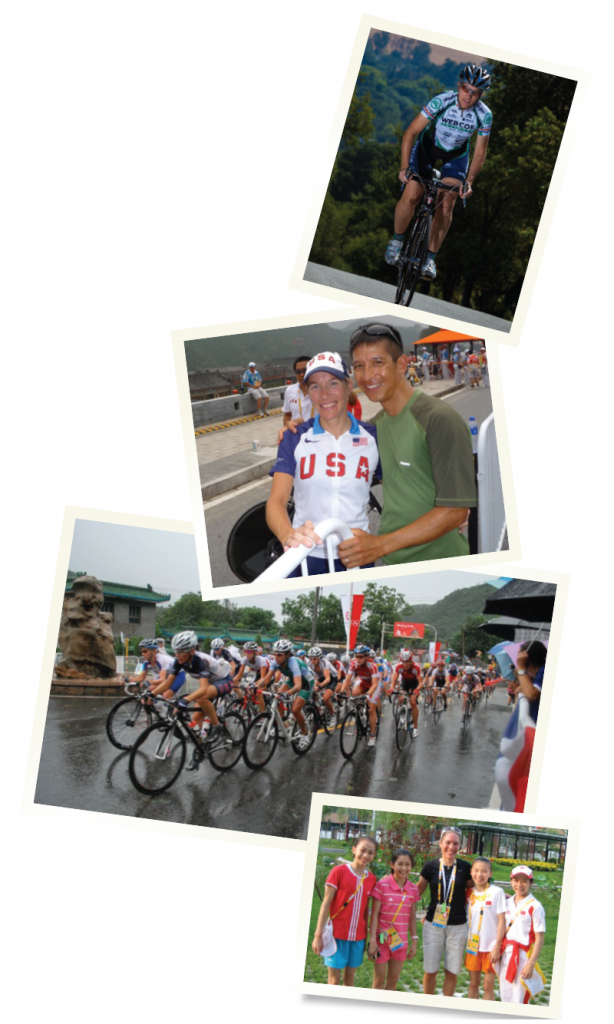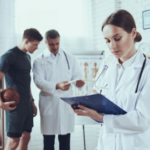Growing up in Iowa, Christine Thorburn, MD, loved to run track and cross-country and dreamed of one day being an Olympic runner. Little did the future rheumatologist know that a knee injury would cause her to change course and become a professional road cyclist who would represent the U.S. in two Olympic Games.
Dr. Thorburn remembers being a graduate student at Stanford University School of Medicine when she began experiencing increased knee pain while running downhill.
“I tore my ACL and meniscus while in junior high,” says Dr. Thorburn, 48, who now works as a rheumatologist at the Palo Alto Medical Foundation in Palo Alto, Calif. “I continued to run cross-country while completing my undergraduate degree at Grinnell College in Iowa, but at Stanford, my old knee injury began causing me pain, and I knew I needed to quit running.”
A classmate invited Dr. Thorburn to take join the Stanford cycling team, a group that boasts bike riders of all disciplines and experience levels. Dr. Thorburn quickly fell in love with the sport and found the moderate California climate lent itself well to biking on a yearround basis.
Not only did she enjoy biking, Dr. Thorburn found she was also good at the sport. In 1998, the same year she joined the Stanford team, she qualified for the Collegiate National Championships.
“I was competitive locally, but I never thought of the possibility of competing on an international basis,” Dr. Thorburn says.
In 2001, Dr. Thorburn began her rheumatology fellowship at Stanford, and the following year, she underwent knee surgery to repair her old running injury. Dr. Thorburn finished her fellowship at Stanford and began performing research, allowing her more time to train.
“I would wake up early to train and cycle around Palo Alto with a headlamp on,” Dr. Thorburn says. “[Because] I was doing research work in clinical epidemiology, I had more flexibility and could work in the evening.”
In 2003, Dr. Thorburn experienced a breakthrough season as a road cyclist. It was the year she attempted the inaugural T-Mobile International women’s bike race, which includes a daunting four-block climb up the Fillmore Street hill in San Francisco. She finished as the second best American rider in the race and was invited to participate in the World Championships in Canada that same year.
Taking the International Stage

Dr. Thorburn came in 4th in the Olympic time trials in 2004 and 5th in 2008.
Dr. Thorburn with her husband, Ted Huang, after the time trial in the Beijing Olympics in 2008.
Dr. Thorburn is at the front of a very rainy road race at the 2008 Olympics in Beijing.
Dr. Thorburn in the Olympic Village in Beijing with the Chinese gymnastics team in 2008.
Competing in the Olympics began to seem like a real possibility for Dr. Thorburn. She began training with the Webcor Builders women’s cycling team in Palo Alto and won the 24 km national women’s cycling elite time trial championship in Redlands, Calif., which earned her the opportunity to compete in the 2004 Olympic Games held in Athens, Greece, with teammates Kristin Armstrong and Dede Berry.
On the Webcor team, Dr. Thorburn worked with Karen Brems, world champion in the inaugural women’s time trial event held in Italy in 1994 who also raced in the 2000 Sydney Olympics. Through biking, Dr. Thorburn also met her husband, Ted Huang, a former Olympic windsurfer who competed in the 1996 Olympic Games in Atlanta and the 2000 Olympics in Australia, finishing ninth and 13th, respectively.
“In preparation for the Olympics, I trained four days a week, doing a combination of cycling and exercises to build my core strength, such as Pilates,” Dr. Thorburn says. “I was completing my fellowship in rheumatology at the time and was almost done with my clinical requirements. Everyone at Stanford was very supportive.”
At the Olympic Games in Athens, Dr. Thorburn competed in both the road race and time trial events, finishing fourth in the time trial, a bittersweet end to her first Olympics.
“It’s ingrained in Olympic athletes to go for that medal, so to finish fourth, it’s easy to feel as though your ride wasn’t worthwhile,” Dr. Thorburn says.
The following year she began her postdoctoral research at the University of California, San Francisco, and continued to race in her free time. She went on to win a bronze medal in the 2006 Union Cycliste Internationale (UCI) World Race Championships, one of the selection criteria needed to compete in the 2008 Summer Olympic Games in Beijing.
“I decided to continue racing and training for the Beijing games, although looking back, I’m not sure how I balanced it all,” says Dr. Thorburn, who was a rheumatology fellow during her first Olympic games and a practicing physician for the second games in 2008. “I was granted a four-month leave of absence to go to Europe to compete and prepare for the Summer Olympics.”
In Beijing, Dr. Thorburn found that although the race course was harder, with a longer climb than in Athens, the Chinese were very prepared and had even managed to take care of the worrisome pollution problem. Although she narrowly missed a spot on the podium, finishing in fifth place just three seconds off the bronze medal, she savors her Olympic experiences.
“It was an honor to be a part of two Olympic games,” Dr. Thorburn says. “To be in the Olympic Village, and to watch other events, such as gymnastics and basketball, was quite memorable.”
Supporting the Arthritis Community
Although Dr. Thorburn is retired from the professional racing circuit, she continues to compete in arthritis-connected charity rides for various groups, including the Arthritis Foundation. Knowing how it feels to have osteoarthritis in her knee also helps her understand what many of her patients are going through.
“I hope it makes me more relatable,” Dr. Thorburn says. “I do encourage my arthritis patients to keep moving and to do low-impact activities, such as walking, swimming or riding a stationary bike, to keep their muscles strong and their joints flexible.”
Dr. Thorburn continues to ride 8–10 miles two days a week from her home to her job at the Palo Alto Medical Foundation.
“I bike commute as much as possible,” Dr. Thorburn says. “It’s not only an exercise that I enjoy, but it also helps reduce air pollution.”
Linda Childers is a health writer located in the San Francisco Bay Area.


